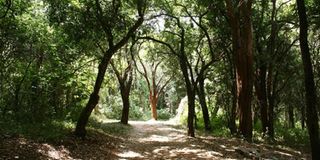Perfect date with nature

A shaded trail in Oloolua Forest. In areas with plenty of trees, thick clumps of growth appear relatively clearly in satellite images, even at low resolution, and are easily distinguishable from bare land.
What you need to know:
- Oloolua Forest is a nice escape for humans and dogs.
- As Oloolua is split by the SGR, Ngong Road Forest is split by the Southern Bypass.
Last week’s article was all about the new Land Rover Defender, which I had the opportunity to test in Oloolua Forest. The dirt tracks that we used were beneath the standard gauge railway (SGR), which runs right across the southern portion of the forest.
Recently, I’ve written a few articles for this column about Nairobi’s forests, and the encroachment of the city’s infrastructure has been a common theme. As Oloolua is split by the SGR, Ngong Road Forest is split by the Southern Bypass. I hadn’t visited Oloolua Forest before, so I was keen to explore what is left of it.
It also sounded like a great afternoon out for our new four-month old German Shepherd, Riley. There isn’t much information online about the forest, and the little I knew about it was mainly from family and friends who live in the area.
I did find a brief summary about it on the website of the Institute of Primate Research (IPR), which has an office in the forest and manages the nature trail. I’m not sure how I feel about such a biomedical research facility within a habitat for wild monkeys, but I don’t know enough about their work to comment.
Because the main gate is right at the southern end of Karen Road past the sharp turn onto Bogani Road, it wasn’t too difficult to find. Here I met Joachim, a guide who offered to show me around the forest.
Simple loop
He said a simple loop round the trail was only five kilometres, but I thought it would be nice to be guided round the main spots.
So, with Riley in tow, we wandered down the main path away from the gate. It wasn’t long before we arrived at the first attraction – the Bird Tower. This tall, rectangular wooden structure reached the tree canopy, and contained a staircase to a high bird-viewing platform.
According to Joachim, it had been built in the 1970s for an American ornithologist studying crowned eagles. It’s now mainly used as storeroom.
We continued down the main trail until we came across some ramshackle wooden steps, leading down into a small valley. Too technical a descent for Riley, who I had to carry down. Not much further was an attractive waterfall. Beside it was a network of rattling rusted pipes, feeding into a whirring pump and water tank.
Waterfall’s charm
Because the system looked so aged and jua kali, it contributed to the waterfall’s charm in a weird way. Plus we were enjoying it on our own – it was a Tuesday so the forest was very quiet.
Next we wandered through the ‘Bamboo Zone’, a very nice little stretch by the river, which Joachim told me was the Mbagathi River. Here we did have some company – two young men having a photo shoot with a bamboo backdrop.
It’s quite peaceful down here, with a few scattered benches on the riverbank beneath overhanging bamboo canopies.
I clambered up another set of stairs, Riley in hand, and walked to an impressive cave, which Joachim said was a hiding spot for Mau Mau fighters before independence. He also said it was 100 metres deep, although the IPR website says it’s just 37. Either way, you can walk in a long way before it gets too narrow. The only downside was the graffiti on the walls of the entrance.
We had time to explore some campsites, too, which were surrounded by dense indigenous forest. Even though Oloolua isn’t entirely fenced, Joachim assured me that it was safe to camp, and they provide a number of askaris.
So I was generally quite impressed by the forest. It’s a nice escape for humans and dogs, and I’m sure Riley would agree.
Entrance fee is Sh200 for citizens, 400 for residents and 800 for non-residents. Camping for groups below 10 people is Sh5,000.





